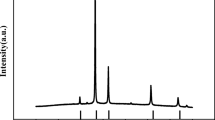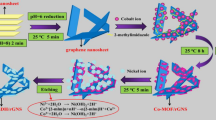Abstract
This work reports a feasible method to fabricate a simple chemical functionalization of graphene oxide (GO) electrode. The hydrothermal synthesis of nitrogen-doped graphene quantum dots modified reduced graphene oxide (NGDQs/rGO-2) using ammonium citrate and graphene oxide (GO) as raw materials. Ammonium citrate effectively acts as a nitrogen dopant cum reducing agent for graphene which remarkably enhances its electrochemical properties. Diffraction of X-rays (XRD), Fourier transform infrared spectroscopy (FTIR), scanning electron microscopy (SEM), transmission electron microscope (TEM), and X-ray photoelectron spectroscopy (XPS) were employed to characterize the structure and properties of the (NGDQs/rGO-2), and the NGDQs/rGO-2 was used as the electrode to test the electrochemical performance. According to the electrochemical test results, when the molar ratio of NGDQs to rGO is 1:2, the specific capacitance can reach 357 F/g at a current density of 1 A/g; after 1000 cycles, the capacitance retention rate is 82%. For comparison, under the same current density condition, the specific capacitance of the rGO electrode is only 74 F/g. By assembling a symmetrical supercapacitor for double electrode test, the specific capacitance can reach 237 F/g at a low current density of 0.5 A/g. As the current density increases, the capacitance decreases slightly. When the current density is 1 A/g, the specific capacitance is 113 A/g. Thus, the synthesized NGDQs/rGO-2 using this simple, cost-effective, environment friendly method could be a potential candidate for high performance energy-storage applications.









Similar content being viewed by others
Data availability
All data generated or analysed during this study are included in this published article [and its supplementary information files].
References
Nguyen TH, Yang D, Zhu B, Lin H, Ma TY, Jia BH (2021) Doping mechanism directed graphene applications for energy conversion and storage. J Mater Chem A 9:7366–7395
Zhao SQ, Guo ZQ, Yan K, Wan SW, He FR, Sun B, Wang GX (2020) Towards high-energy-density lithium-ion batteries: strategies for developing high-capacity lithium-rich cathode materials. Energy Stor Mater 34:716–734
Wang Y, Gan SJ, Meng J, Yang JJ, Li J, Liu H, Shi L, Chen L (2021) Layered nanofiber yarn for high-performance flexible all-solid supercapacitor electrodes. J Phys Chem C 125:1190–1199
Grahame DC (1947) The electrical double layer and the theory of electrocapillarity. Chem Rev 41:441–501
Liu YN, Li HL, Wang X, Lv T, Dong KY, Chen ZL, Yang YL, Cao SK, Chen T (2021) Flexible supercapacitors with high capacitance retention at temperatures from -20 to 100 °C based on DMSO-doped polymer hydrogel electrolytes. J Mater Chem A 9:12051–12059
González A, Goikolea E, Barrena JA, Mysyk R (2016) Review on supercapacitors: technologies and materials. Renew Sustain Energy Rev 58:1189–1206
Wang HM, Yang HR, Diao YF, Lu Y, Chrulski K, D’Acry JM (2021) Solid-state precursor impregnation for enhanced capacitance in hierarchical flexible poly (3, 4-ethylenedioxythiophene) supercapacitors. ACS Nano 15:7799–7810
Chebrolu VT, Balakrishnan B, Cho I, Bak JS, Kim HJ (2020) A unique core–shell structured ZnO/NiO heterojunction to improve the performance of supercapacitors produced using a chemical bath deposition approach. Dalton Trans 49:14432–14444
Xie LJ, Su FY, Xie LF, Guo XQ, Wang ZB, Kong QQ, Sun GH, Ahmad A, Li XM, Yi ZL, Chen CM (2020) Effect of pore structure and doping species on charge storage mechanisms in porous carbon-based supercapacitors. Mater Chem Front 4:2610–2634
Peres NMR (2009) The electronic properties of graphene and its bilayer. Vacuum 83:1248–1252
Sundar JV, Subramanian V (2013) Novel chemistry for the selective oxidation of benzyl alcohol by graphene oxide and N-doped graphene. Org Lett 15:5920–5923
Zhu YW, Murali S, Cai WW, Li XS, Suk JW, Potts JR, Ruoff RS (2010) Graphene and graphene oxide: synthesis, properties, and applications. Adv Mater 22:3906–3924
Zhou QX, Ju WW, Yong YL, Zhang Q, Liu JL (2020) Effect of the N/P/S and transition-metal co-doping on the quantum capacitance of supercapacitor electrodes based on mono-and multilayer graphene. Carbon 170:368–379
Bardi N, Giannakopoulou T, Vavouliotis A, Trapalis C (2020) Electrodeposited films of graphene, carbon nanotubes, and their mixtures for supercapacitor applications. ACS Appl Nano Mater 3:10003–10013
Zhao ZY, Liu ZH, Zhong QS, Qin YJ, Xu AZ, Li W, Shi JH (2020) In situ synthesis of trifluoroacetic acid-doped polyaniline/reduced graphene oxide composites for high-performance all-solid-state supercapacitors. ACS Appl Energy Mater 3:8774–8785
Zhao J, Zhu JY, Li YT, Wang LX, Dong Y, Jiang ZM, Fan CW, Cao YL, Sheng R, Liu AJ, Zhang S, Song HH, Jia DZ, Fan ZJ (2020) Graphene quantum dot reinforced electrospun carbon nanofiber fabrics with high surface area for ultrahigh rate supercapacitors. ACS Appl Mater Interfaces 12:11669–11678
Huang QT, Lin XF, Tong LL, Tong QX (2020) Graphene quantum dots/multiwalled carbon nanotubes composite-based electrochemical sensor for detecting dopamine release from living cells. ACS Sustain Chem Eng 8:1644–1650
Kaur M, Ubhi MK, Grewal JK, Sharma VK (2021) Boron-and phosphorous-doped graphene nanosheets and quantum dots as sensors and catalysts in environmental applications: a review. Environ Chem Lett 19:4375–4392
Yu ZC, Ma WH, Wu T, Wen J, Zhang Y, Wang LY, He YQ, Chu HT, Hu MG (2020) Coumarin-modifed graphene quantum dots as a sensing platform for multicomponent detection and its applications in fruits and living Cells. ACS Omega 5:7369–7378
Zhang B, Xiao CH, Xiang Y, Dong BT, Ding SJ, Tang YH (2016) Nitrogen-doped graphene quantum dots anchored on thermally reduced graphene oxide as an electrocatalyst for the oxygen reduction reaction. ChemElectroChem 3:864–870
Luo Y, Li M, Sun L, Xu YJ, Hu GH, Tang T, Wen JF, Li XY (2017) Tuning the photoluminescence of graphene quantum dots by co-doping of nitrogen and sulfur. J Nanopart Res 19:363
Ma YY, Yuan WY, Bai YH, Wu H, Cheng LF (2019) The toughening design of pseudocapacitive materials via graphene quantum dots: towards enhanced cycling stability for supercapacitors. Carbon 154:292–300
Kapoor S, Jha A, Ahmad H, Islam SS (2020) Avenue to large-scale production of graphene quantum dots from high-purity graphene sheets using laboratory-grade graphite electrodes. ACS Omega 5:18831–18841
Yuan WJ, Zhou Y, Li YR, Li C, Peng HL, Zhang J, Liu ZF, Dai LM, Shi GQ (2013) The edge-and basal-plane-specific electrochemistry of a single-layer graphene sheet. Sci Rep 3:1–7
Ebrahimi M, Kermanpur A, Atapour M, Adhami S, Heidari RH, Khorshidi E, Irannejad N, Rezaie B (2020) Performance enhancement of mesoscopic perovskite solar cells with GQDs-doped TiO2 electron transport layer. Sol Energy Mater Sol Cells 208:110407
Wu H, Guo ZS, Li M, Hu GH, Tang T, Wen JF, Li XY, Huang HF (2021) Enhanced pseudocapacitive performance of MoS2 by introduction of both N-GQDs and HCNT for flexible supercapacitors. Electrochim Acta 370:137758
Li Z, Bu F, Wei JJ, Yao WW, Wang L, Chen ZW, Pan DY, Wu MH (2018) Boosting the energy storage densities of supercapacitors by incorporating N-doped graphene quantum dots into cubic porous carbon. Nanoscale 10:22871–22883
Ganganboina AB, Doong RA (2020) Nitrogen doped graphene quantum dot-decorated earth-abundant nanotubes for enhanced capacitive deionization. Environ Sci Nano 7:228–237
Chen F, Liu LL, Zhang YJ, Wu JH, Huang GX, Yang Q, Chen JJ, Yu HQ (2020) Enhanced full solar spectrum photocatalysis by nitrogen-doped graphene quantum dots decorated BiO2-x nanosheets: ultrafast charge transfer and molecular oxygen activation. Appl Catal B-Environ 277:119218
Nascimento JRD, D'Oliveira MR, Veiga AG, Chagas CA, Schmal M (2020) Synthesis of reduced graphene oxide as a support for nano copper and palladium/copper catalysts for selective NO reduction by CO. ACS Omega 5:25568–25581
Turkaslan BE, Aydin MF (2020) Optimizing parameters of graphene derivatives synthesis by modified improved Hummers. Math Methods Appl Sci 8:1–8
Aragaw BA (2020) Reduced graphene oxide-intercalated graphene oxide nano-hybrid for enhanced photoelectrochemical water reduction. J Nanostructure Chem 10:9–18
Gong XB, Wang Y, Yao K, Yang JJ, Li YN, Ge X, Xie HJ, Pan GF, Xing RG (2023) Supercapacitors based on Resveratrol/reduced graphene oxide composites. ACS Appl Nano Mater 6:4162–4169
Yap PL, Kabiri S, Auyoong YL, Tran DNH, Losic D (2019) Tuning the multifunctional surface chemistry of reduced graphene oxide via combined elemental doping and chemical modifications. ACS omega 4:19787–19798
Tarcan R, Handrea-Dragan M, Todor-Boer O, Petrovai I, Farcau C, Rusu M, Vulpoi A, Todea M, Astilean S, Botiz I (2020) A new, fast and facile synthesis method for reduced graphene oxide in N. N-dimethylformamide Synth Met 269:116576
Karaman C, Bayram E, Karaman O, Akta Z (2020) Preparation of high surface area nitrogen doped graphene for the assessment of morphologic properties and nitrogen content impacts on supercapacitors. J Electroanal Chem 868:114197
Qing Y, Jiang YT, Lin H, Wang LX, Liu AJ, Cao YL, Sheng R, Guo Y, Fan CW, Zhang S, Jia DZ, Fan ZJ (2019) Boosting the supercapacitor performance of activated carbon by constructing overall conductive networks using graphene quantum dots. J Mater Chem A 7:6021–6027
Kakaei K, Hamidi M, Husseindoost S (2016) Chlorine-doped reduced graphene oxide nanosheets as an efficient and stable electrode for supercapacitor in acidic medium. J Colloid Interface Sci 479:121–126
Zheng F, Xi CP, Xu JH, Yu Y, Yang WG, Hu PF, Li Y, Zhen Q, Bashir S, Jingbo JL (2019) Facile preparation of WO3 nano-fibers with super large aspect ratio for high performance supercapacitor. J Alloys Compd 772:933–942
Chen J, Chang B, Liu FR, Wei HM, Wei W, Liu HL, Han S (2019) Modification of porous carbon with nitrogen elements to enhance the capacitance of supercapacitors. J Mater Sci 54:11959–11971
Zhang R, Shen WZ, Zhong M, Zhang JL, Guo SW (2020) Carbon nanofibers cross-linked and decorated with graphene quantum dots as binder-free electrodes for flexible supercapacitors. J Phys Chem C 125:143–151
Xing RG, Gong XB, Zhuang XX, Li YA, Bulin CK, Ge X, Zhang BW (2022) Synthesis and improved electrochemical properties of nitrogen-doped graphene quantum dot–modifed polyaniline. J Nanopart Res 24:32
Funding
This work was financially supported by the Natural Science Foundations of Inner Mongolia Autonomous Region (No. 2018LH05020, 2018LH02003); the Inner Mongolia Science and Technology Innovation Oriented Project (No. KCBJ2018032) and Program for Young Talents of Science and Technology in Universities of Inner Mongolia Autonomous Region (NJYT23004).
Author information
Authors and Affiliations
Contributions
XB: Conceptualization, Methodology, Experiment, Software, Investigation, Formal Analysis, Writing—Original Draft; , JJ: Data Curation, Writing—Original Draft; K: Visualization, Investigation; YN: Resources, Supervision, Writing—Review and Editing; GF: Software, Validation; X: Visualization, Writing—Review and Editing; Z: Additional experiments Writing; RG: Conceptualization, Funding Acquisition, Resources, Supervision, Writing—Review and Editing.
Corresponding authors
Ethics declarations
Ethics approval
Written informed consent for publication of this paper was obtained from the Inner Mongolia University of Science and Technology and all authors
Competing interests
The authors declare no competing interests.
Additional information
Publisher’s note
Springer Nature remains neutral with regard to jurisdictional claims in published maps and institutional affiliations.
Supplementary information
ESM 1
(DOCX 253 kb)
Rights and permissions
Springer Nature or its licensor (e.g. a society or other partner) holds exclusive rights to this article under a publishing agreement with the author(s) or other rightsholder(s); author self-archiving of the accepted manuscript version of this article is solely governed by the terms of such publishing agreement and applicable law.
About this article
Cite this article
Gong, X., Yang, J., Yao, K. et al. Synthesis of 3D nitrogen-doped graphene quantum dots and reduced graphene oxide composites by a hydrothermal method for supercapacitors anodes. Ionics 29, 3273–3285 (2023). https://doi.org/10.1007/s11581-023-05057-0
Received:
Revised:
Accepted:
Published:
Issue Date:
DOI: https://doi.org/10.1007/s11581-023-05057-0




